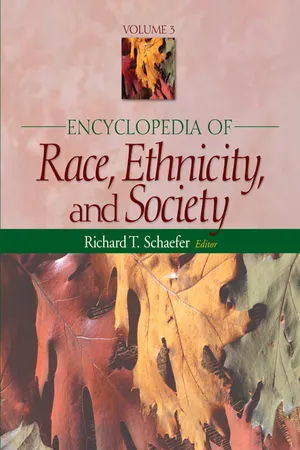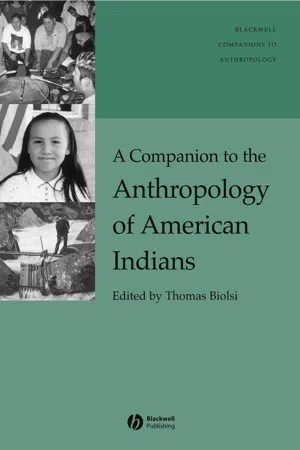History
Native American Society
Native American society refers to the diverse cultures, traditions, and social structures of the indigenous peoples of North and South America prior to European colonization. These societies were often organized around kinship, with distinct languages, belief systems, and ways of life. They had complex social, political, and economic systems, and their interactions with European settlers significantly impacted their way of life.
Written by Perlego with AI-assistance
Related key terms
1 of 5
3 Key excerpts on "Native American Society"
- eBook - PDF
- Richard T. Schaefer(Author)
- 2008(Publication Date)
- SAGE Publications, Inc(Publisher)
Typically, the governance structure of these groups was decentralized, based in consensual forms of governance, where all the adult members of the kinship community, male and female, were part of the decision-making process. Until the late 18th century, then, when European col- onization was well advanced, the Indigenous Peoples north of Mexico did not typically think of themselves as “Indians” or their social organizations as “tribes” or “nations,” another term applied to and adopted by these communities in the United States once the treaty- making process had begun. Rather, they identified themselves according to the name of the kinship group or clan to which they belonged. Writing in 1829, the Pequot activist William Apess testifies in his autobiog- raphy, A Son of the Forest, to the alien origin of the word “Indian,” even as he uses it to identify himself: I thought it disgraceful to be called an Indian; it was considered as a slur upon an oppressed and scattered nation, and I have often been led to inquire where the Whites received this word, which they so often threw as an opprobrious epithet at the sons of the forest. Apess thought that his people should properly be called “Natives.” Today, Indians in the United States have taken up both the words Indian and Native as their own; but, as Apess suggests, this process of translation was slow and painful, based as it is in the genocidal violence of European colonialism. Because the basic indigenous social unit was not founded on biological identification but on complex cultural affiliations, outsiders could be adopted into the community as full-fledged members if they were willing to follow the social and cultural rules of kin- ship. The history of Europeans and others, including African Americans, being taken captive by or willingly joining Native communities witnesses this process of cultural conversion or adoption. - Thomas Biolsi(Author)
- 2008(Publication Date)
- Wiley-Blackwell(Publisher)
As has become readily clear to anthropologists and native communities, none of these questions of representation is ever very far re-moved from very present, often very pressing, questions of political and economic survival for the communities involved. In this way, the conjoined nature of these two elements – culture and politics – for Native Americans is complex, and their involution challenges anthropology in ways that notions of ‘‘collaboration’’ find difficult to accommodate fully. The remainder of this chapter is devoted to discovering in more specific terms why this is the case – how it is that talk about native culture in general (and not just talk by anthropologists) has come to be seen by many (both native and non-native) as ‘‘dangerous words,’’ in Jeanne Favrett-Saada’s terms (1980). The method for this argument, however, is not to look yet again at the complexities of studying native culture; but rather, to look at the politics of representation and collaboration from a perspective that asks why having native culture is made so complex and problematic for Native American communities themselves by their growing participation in the North American political economy that surrounds them. Three particular, somewhat separate, issues link Native American culture to larger questions of politics on a scale outside their own communities: 1 Indigenous Claims. Native peoples in North America are distinct from other racial or ethnic minorities in the United States both in the eyes of power and in their own eyes for reasons that have largely to do with claims on specific pieces of property, claims based on aboriginal ownership. 2 The Normalization of Native Marginality. While claims to resources were once enforceable by native groups themselves, much of the history of U.S./Native American relations over the last 200 years has been aimed at forcing natives’ claims into the bureaucratic structure of the U.S.- eBook - PDF
Preventing Child Maltreatment in the U.S.
American Indian and Alaska Native Perspectives
- Royleen J Ross, Julii M Green, Milton A Fuentes(Authors)
- 2022(Publication Date)
- Rutgers University Press(Publisher)
8 1 Understanding American Indian and Alaska Native Families from the Precolonial and Contemporary Context At one point, if you drew a circle, the medicine people were Aboriginal, the medicine was Aboriginal, nurses, teachers were Aboriginal. But as colonization evolved and you looked at the circle, there were no Aboriginals. —Chief Robert Joseph In consideration of contextualizing the history of the United States Indigenous Nations, there is no comprehensive, verifiable, and mutu- ally agreed upon documentation of Native American history. The majority of tribes had no written language; thus, Our histories were kept through the oral tradition, which we realize often produces variable perceptions of Our past(s). With that said, the portrayal the Understanding American Indian and Alaska Native Families • 9 authors present coalesces some general concepts and remembrances as articulated by a collection of respected elder Native scholars and traditional men and women who are recognized as credible resources. In addition, we rely heavily on Native scholarly books, articles, and manuscripts to maintain the authenticity of Our voices, historically and contemporarily. These purposeful efforts seek to gather and artic- ulate a general understanding of how American Indian/Alaska Native children were raised, the roles of women, and how those intersections counter violence and historical trauma. Collectivistic Cultural Orientation Traditional American Indian and Alaska Native (AI/AN) family structures are generally extended-family-based and collectivistic in orientation. According to Dr. D. Subia Bigfoot, AI/AN “families come from traditionally honor based and respectful societies” (per- sonal communication, April 5, 2018). Romero-Little et al. (2014), referring to a southwest Indigenous population, stated, “Collec- tivistic values are manifested in cultural constructs and in cultural approaches to socializing their children” (p. 164).
Index pages curate the most relevant extracts from our library of academic textbooks. They’ve been created using an in-house natural language model (NLM), each adding context and meaning to key research topics.


